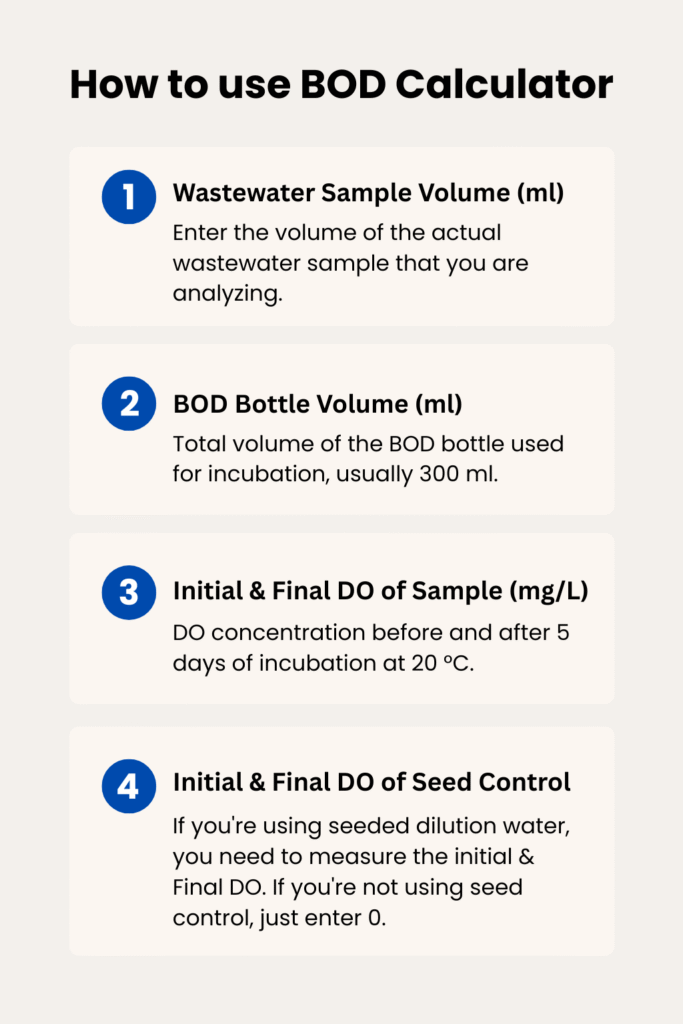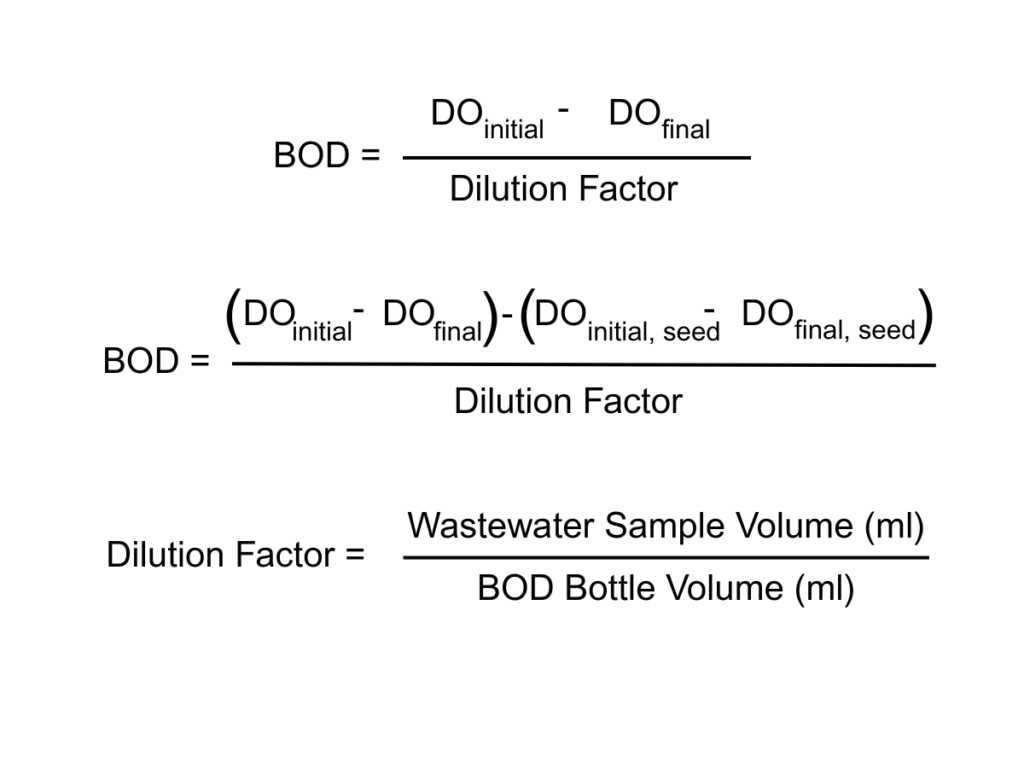Biochemical Oxygen Demand Calculator: A Powerful Tool for Water Quality Assessment

By Fluvyl, updated Apr 21, 2025

Biochemical Oxygen Demand (BOD) is one of the most important parameters used to assess the level of organic pollution in water. It measures the amount of dissolved oxygen required by aerobic microorganisms to break down organic matter present in a water sample. High BOD levels usually indicate a high concentration of biodegradable material, which can reduce oxygen levels in water bodies and harm aquatic life.
To simplify the process of BOD calculation, environmental professionals, engineers, and students often rely on digital tools. One such essential tool is the Biochemical Oxygen Demand Calculator. This calculator makes it easy to compute BOD values quickly and accurately, based on your lab data.
In this article, we’ll explore what the Biochemical Oxygen Demand Calculator is, its significance in water quality monitoring, how it works, and how to use it step-by-step. Whether you’re a student, a wastewater treatment operator, or a consultant, understanding how to use this calculator effectively will make your job easier and your results more precise.

BOD Calculator
ADVERTISEMENT
Formula Used

What is a Biochemical Oxygen Demand Calculator?
A Biochemical Oxygen Demand Calculator is a digital tool—either web-based, mobile-based, or desktop software—that calculates the BOD of a water or wastewater sample. This calculation is usually based on two Dissolved Oxygen (DO) readings:
- Initial DO (Day 0)
- Final DO (after 5 days or more of incubation)
The calculator helps users determine how much oxygen was consumed by microbes over a given time, typically 5 days at 20°C (referred to as BOD₅).
This tool eliminates the need for manual calculation, reducing human error and saving time. Engineers working on wastewater treatment plant (WWTP) design or performance evaluation frequently use the Biochemical Oxygen Demand Calculator for efficiency and consistency.
Biochemical oxygen demand calculation is a fundamental process in assessing the quality of wastewater and the efficiency of sewage treatment systems. This calculation measures the amount of dissolved oxygen needed by aerobic microorganisms to break down organic matter in water over a specific period, usually five days. Accurate biochemical oxygen demand calculation is essential for determining the organic pollution load in wastewater, which helps treatment plant operators design and optimize processes for maximum efficiency.
One of the primary reasons for conducting a biochemical oxygen demand calculation is to evaluate the environmental impact of effluent discharged into natural water bodies. High BOD levels indicate a high concentration of biodegradable material, which can deplete oxygen levels in receiving waters and harm aquatic life. Therefore, regular and precise biochemical oxygen demand calculation is critical for meeting environmental regulations and ensuring the health of aquatic ecosystems.
To perform a biochemical oxygen demand calculation, samples are typically incubated at 20°C for five days in the dark, and the difference in oxygen concentration before and after incubation is measured. The results guide the adjustment of treatment methods, such as aeration or biological treatment processes, to reduce BOD levels in the final discharge.
Moreover, biochemical oxygen demand calculation is also used for monitoring the performance of biological treatment units, identifying operational issues, and tracking improvements in wastewater treatment over time. It serves as a valuable tool for environmental engineers, plant operators, and regulatory agencies. In summary, the biochemical oxygen demand calculation not only ensures compliance with discharge standards but also plays a key role in protecting water resources and maintaining ecological balance.
Why is BOD Important?
Before diving into how the calculator works, it’s important to understand why BOD is a crucial parameter:
- Indicator of Organic Pollution: High BOD levels signal the presence of excessive biodegradable material.
- Effluent Quality Check: Wastewater treatment plants use BOD to check how well their treatment processes are working.
- Compliance Monitoring: Environmental agencies set discharge limits for BOD to protect water bodies.
- Environmental Impact: Lower oxygen levels due to high BOD can result in fish kills and ecological imbalance.
The Biochemical Oxygen Demand Calculator allows for real-time and retrospective analysis of water samples to ensure environmental compliance.
How to Use a Biochemical Oxygen Demand Calculator: Step-by-Step Guide
Using a Biochemical Oxygen Demand Calculator is simple. Here’s a step-by-step guide that works for most web-based and software versions:
Step 1: Gather Lab Data
Before using the calculator, collect the following data from your BOD test:
- Initial DO (Day 0)
- Final DO (Day 5 or after incubation)
- Sample volume
- Dilution factor (if any)
- Temperature and incubation period
Step 2: Access the Calculator
Go to your preferred Biochemical Oxygen Demand Calculator online or open the app/software you’re using. Many environmental websites (like Fluvyl) offer a free BOD calculator.
Step 3: Input Values
Fill in the required fields:
- DO Initial: e.g., 8.5 mg/L
- DO Final: e.g., 3.2 mg/L
- Volume: e.g., 300 mL
- Dilution factor: e.g., 1.0
Step 4: Hit Calculate
Once all values are entered, click the “Calculate” button. The calculator will instantly provide the BOD value in mg/L.
Step 5: Analyze Results
Compare the result with permissible discharge limits. For example:
- Treated sewage BOD ≤ 20 mg/L (India CPCB Standard)
- Industrial discharge may have different limits
Use the result to decide whether further treatment is required or not.
Key Features of a Good Biochemical Oxygen Demand Calculator
If you’re choosing a calculator for regular use, make sure it includes these features:
- User-friendly interface
- Multiple unit options
- Error alerts for unrealistic inputs
- Downloadable reports
- Graphical analysis of BOD trends
- Mobile-friendly design
The Fluvyl website provides a Biochemical Oxygen Demand Calculator with all these features, designed especially for environmental students and professionals.
Applications of the Biochemical Oxygen Demand Calculator
The calculator is widely used in various fields:
| Application Area | Purpose |
|---|---|
| Wastewater Treatment Plants | Effluent quality testing |
| Environmental Engineering | Monitoring of lakes, rivers, and wetlands |
| Industrial Audits | Compliance with environmental laws |
| Academic Institutions | Teaching and lab practical analysis |
| Research and Consultancy | Modeling pollution loads |
In each of these areas, the Biochemical Oxygen Demand Calculator saves time, enhances accuracy, and supports better decision-making.
Benefits of Using a Biochemical Oxygen Demand Calculator
Here are the major advantages:
- Faster Results: Instant calculation without manual work
- Improved Accuracy: Reduces human calculation errors
- Documentation Ready: Most calculators allow you to export results
- Data Monitoring: Store, compare, and analyze past BOD values
- Educational Value: Helps students visualize BOD principles easily
In short, the Biochemical Oxygen Demand Calculator is an indispensable tool in any environmental professional’s digital toolkit.
Final Thoughts
In the modern era of digital water management, tools like the Biochemical Oxygen Demand Calculator have become essential for accurate, efficient, and fast water quality monitoring. Whether you’re working on a full-scale wastewater treatment plant or conducting academic experiments, this calculator simplifies the process and minimizes errors.
With just a few inputs, you can get reliable BOD results, make informed decisions, and ensure environmental compliance. For engineers, students, and researchers alike, learning how to use the Biochemical Oxygen Demand Calculator is a must.
If you’re looking for a free, accurate, and easy-to-use version of this tool, check out the one available on the Fluvyl website. It’s built to help you calculate BOD like a pro—no spreadsheets, no stress.
